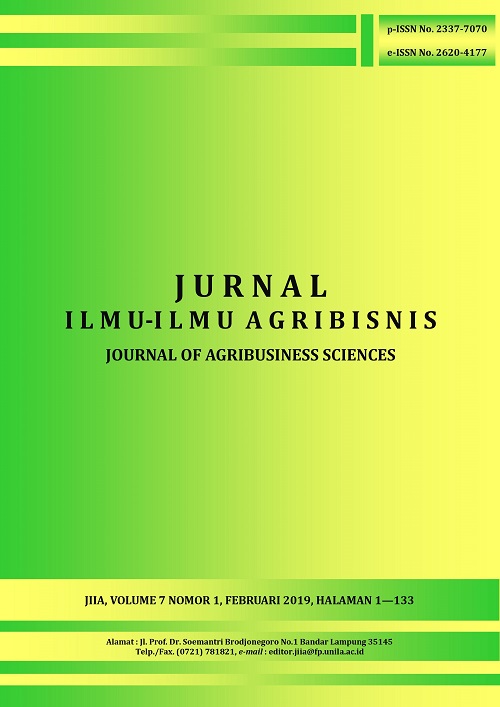POLA KONSUMSI PANGAN RUMAH TANGGA PADA DESA PELAKSANA DAN BUKAN PELAKSANA PROGRAM PERCEPATAN PENGANEKARAGAMAN KONSUMSI PANGAN (P2KP) DI KABUPATEN PRINGSEWU
DOI:
https://doi.org/10.23960/jiia.v7i1.3328 Abstract View: 817
Abstract View: 817
Abstract
This research aims to analyze the pattern of food consumption, the pattern of processed local food consumption, and factors that affected the pattern of household food consumption in Pringsewu district. This research was conducted by survey method. Location of this research was determined purposively in Margosari Village North Pagelaran subdistrict as program implementers and Mulyorejo Village Banyumas subdistrict are not program implementers. The amount of research samples in this research was as many as 74 households who were selected by simple random sampling. The data was collected in month of Apri-May 2017. The data was analyzed by descriptive statistic analysis, and verification analysis by demand consumption function model. The result showed that the amount of energy consumption of Margosari village was 5,474.17 kcal/household/day and household energy consumption of Mulyorejo village was 4,745.22 kcal/household/day with their Desirable Dietary Pattern (DDP) score 78.24 and 68.96. Fried bananas was locally processed food sources of energy consumed and have the largest consumption frequency. Cassava was a local food that has the most processed product. Most of household got the processed local food by making them self. The pattern of household food consumption in Pringsewu district was influenced by the household income and number of household’s member.
Key words: consumtion pattern, Desirable Dietary Pattern (DDP) score, local food
Downloads
Downloads
Published
How to Cite
Issue
Section
License
Authors who publish with this journal agree to the following terms:
Authors retain copyright and grant the journal right of first publication with the work simultaneously licensed under a Creative Commons Attribution License that allows others to share the work with an acknowledgement of the work's authorship and initial publication in this journal.
Authors are able to enter into separate, additional contractual arrangements for the non-exclusive distribution of the journal's published version of the work (e.g., post it to an institutional repository or publish it in a book), with an acknowledgement of its initial publication in this journal.
Authors are permitted and encouraged to post their work online (e.g., in institutional repositories or on their website) prior to and during the submission process, as it can lead to productive exchanges, as well as earlier and greater citation of published work (See The Effect of Open Access).














